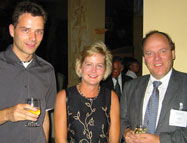 |
|
Axel Weissenfeld, Janet O'Neil,
and Heyno Garbe are shown at the EMC Europe 2002 Welcome
Reception.
|
I don't know about you, but I've been doing a lot of travel lately.
In September, I attended the EMC Europe 2002 conference in Sorrento,
Italy. This was a wonderful experience and I will long remember
the warm hospitality of the conference organizers and the Italian
people. Most notably, I met the members of the International Steering
Committee for EMC Europe and attended a luncheon meeting wherein
several members discussed forming ONE major EMC conference in
Europe in the future. Driving this discussion was the fact that
the popular Zurich, Wroclaw, and United Kingdom EMC conferences,
among others, are beginning to compete for technical papers, the
presence of exhibitors and registrants. Aligning the conferences
into one major annual EMC conference in Europe would resolve these
growing concerns. I was impressed with the caliber of the Steering
Committee. They have noble goals and are committed to working
together to meet these goals. EMC Society President Todd Hubing
mentioned a bit about EMC Europe 2002 in his last President's
Message (Fall 2002). For a summary of this
conference click here.
In November, I attended EMC Brasil 2002 in São Paulo, Brasil.
I helped organize this one-day EMC tutorial and exhibition along
with my fellow Board member Carlos Sartori. It was a challenge
organizing a conference outside the United States and obtaining
a Visa to travel to Brazil. However, once I arrived in Brazil,
as in Italy, I was impressed with the warmth extended by the Brazilians.
The conference was well attended and we received many compliments
for bringing experts on EMC to this rapidly growing IEEE Region
in South America. There were two engineers from Barcelona in attendance
and they asked if we could organize a similar event in their hometown!
We may just start a traveling EMC road show! Click
here for more about EMC Brasil 2002.
In between this international travel, I managed to fit in visits
to some regional EMC Chapters. I attended the November Southeast
Michigan Chapter meeting in Farmington Hills and also the January
Orange County Chapter meeting. Our EMC Chapters are incredible!
The two chapter meetings I attended drew over 30 people to each
meeting, respectively. Enthusiasm for EMC was in the air and there
was some good networking going on. Several chapters, including
Southeastern Michigan and Orange County, are holding one-day EMC
tutorials and exhibitions this year. These are listed in the Calendar
section of this Newsletter. Check it out and plan to attend one
of these events should you happen to be in the area when the event
is being held. You will not be disappointed!
In closing, I do have to mention that I now have a "legacy"
to live up to when I meet people while traveling. This first came
up in Italy, during the Welcome Reception at EMC Europe 2002.
There was a large reflecting pond near the party area. I was surprised
when a stranger approached me and asked in halting English, "Should
we throw a log in the water for you?" I couldn't believe
it! Obviously this fellow saw my performance at the 2002 IEEE
International Symposium on EMC in Minneapolis. Yikes! I may never
live down that experience of logrolling!
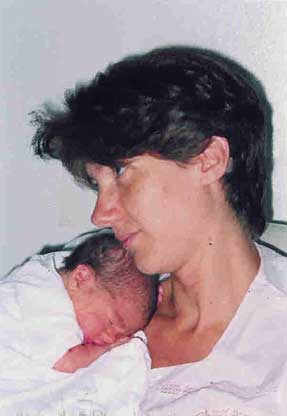 |
| Anna and Antonia Orlandi |
Editor's Note: We have some proud papas in the EMC Society.
EMC Newsletter Associate Editor Todd Robinson welcomed daughter
Raquel Lindsey Robinson just weeks ago! Antonio Orlandi from the
University of L'Aquila, and an active member of the EMC Education
Committee, as well as one of the organizers of EMC Europe 2002,
welcomed daughter Anna Orlandi last year. Congratulations!
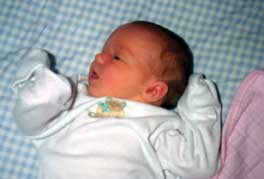 |
| Raquel Lindsey Robinson |
Letters to the Newsletter
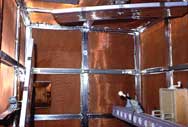 Dear
Editor,
Dear
Editor,
I read the article on the history of EMC activity at NIST (EMC
Society Newsletter, Summer 2002, page19). It was interesting and,
as much as I am able to evaluate, complete. However, it lacks
the recognition of the relevant role played by NIST in promoting
international exchange and in hosting the scientific community.
As regards to reverberating chamber activity, I can add some topping
to the cake as in the following photographs. You can see the first
(1979) reverberating chamber at NBS (please note, this was not
the first reverberating chamber in the United States; others at
that time were operational at Dahlgren Labs, at Litton and at
the McDonnell facility). The reverberating chamber was obtained
by modifying a copper wire mesh shielded room, introducing stirrers
driven by sewing machine motors (bought at the MacGuckin hardware
store in Boulder) and by a robust action in reducing losses by
metallic tape.
 During
field uniformity measurements, a stirrer dropped down and damaged
the best isotropic probe then available at NBS. (I was very remorseful
in relaying news of the accident by phone to Mike Crawford!) In
the photos, there are some of people at work: Mike, and others
(not me, I was taking the pictures!) as well as the structure,
clearly visible, and some sheet pad with the (difficult to see)
preliminary results.
During
field uniformity measurements, a stirrer dropped down and damaged
the best isotropic probe then available at NBS. (I was very remorseful
in relaying news of the accident by phone to Mike Crawford!) In
the photos, there are some of people at work: Mike, and others
(not me, I was taking the pictures!) as well as the structure,
clearly visible, and some sheet pad with the (difficult to see)
preliminary results.
It is an old story, and I was younger then. I never "risked"
more than at that time to spend the rest of my lifetime in the
U.S. However, my wife was (and is) too "Italian," i.e
she loved the ancient monuments, music, spaghetti, and so on.
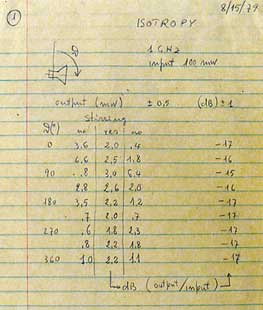 |
|
Best Regards,
Paolo Corona
Instituto Universitario Navale
paolo.corona@uninav.it
Dear Editor:
I read with interest the Education Committee article in the Fall
2002 issue, and in particular the "Wanted: Partners in EMC
Education!" commentary on page 36. I teach an EMC course
as a technical elective for seniors in the Electrical Engineering
program here at Mercer University. At my previous university,
the University of Kentucky, I taught a similar course for over
20 years. An important aspect of that course was the four "minilabs"
I asked the students to complete. They all agreed that these labs
and the ability to actually use real test equipment was one of
the most important learning aspects of the course. The minilabs
I conducted were on (1) measurement and prediction of high-frequency
impedance of components, (2) measurement and prediction of spectral
content of digital clock pulses, (3) measurement and prediction
of crosstalk, and (4) measurement and prediction of radiated emissions
from common-mode currents. All of these labs required quite a
bit of measurement gear to conduct. When I retired from the University
of Kentucky and joined the faculty at Mercer five years ago, I
had to leave all that equipment behind. I am trying to rebuild
that teaching lab and have acquired some of the needed equipment:
a 500 MHz oscilloscope and a HP 8082A Pulse Generator. Fischer
Custom Communications kindly donated a current probe, and ETS-Lindgren
donated a Bicon/Log Periodic antenna. One of the key pieces of
measurement equipment in any lab is a spectrum analyzer. I have
an antique HP141T spectrum analyzer. While it is fairly accurate,
it has none of the modern display capabilities of a modern spectrum
analyzer such as the HP8568B.
This leads me to the purpose of this letter. It is difficult for
people outside academia to realize how "poor" universities
are in terms of their ability to purchase measurement equipment.
Although industry thinks nothing of spending $40,000 for one piece
of gear, that would be out of the question at a university. At
a university, measurement gear can be obtained by only two means:
(1) from research contracts, and (2) from donations by industry
of used equipment. The purpose of this letter is to ask if there
is a company out there that has a HP 8568B spectrum analyzer (or
a HP8566B) that they would be willing to donate to help me build
my lab. This would be used strictly for teaching purposes and
not for research. Although the HP 8568B isn't "state-of-the
art," it's a great deal better than what I've got (HP141T).
I expect that there are EMC companies out there that are upgrading
and would be interested in donating their "old" HP 8568B.
I would also be interested in obtaining the following: (1) HP
4191A RF Impedance Analyzer, (2) HP 8082A Pulse Generator, (3)
various sinusoidal signal oscillators (1kHz-1GHz) (4) a HP 8405A
Vector Voltmeter (5) HP 3400A Voltmeters. I hate to "beg,"
but I have no other way to secure this needed instructional equipment.
If you have any of these and in particular the HP 8568B spectrum
analyzer you would be interested in donating, please contact me
at the email address below. Thanks for any help.
Clayton R. Paul
Dept. of Electrical and
Computer Engineering
Mercer University
Email: Paul_CR@Mercer.edu



 Dear
Editor,
Dear
Editor, During
field uniformity measurements, a stirrer dropped down and damaged
the best isotropic probe then available at NBS. (I was very remorseful
in relaying news of the accident by phone to Mike Crawford!) In
the photos, there are some of people at work: Mike, and others
(not me, I was taking the pictures!) as well as the structure,
clearly visible, and some sheet pad with the (difficult to see)
preliminary results.
During
field uniformity measurements, a stirrer dropped down and damaged
the best isotropic probe then available at NBS. (I was very remorseful
in relaying news of the accident by phone to Mike Crawford!) In
the photos, there are some of people at work: Mike, and others
(not me, I was taking the pictures!) as well as the structure,
clearly visible, and some sheet pad with the (difficult to see)
preliminary results.
